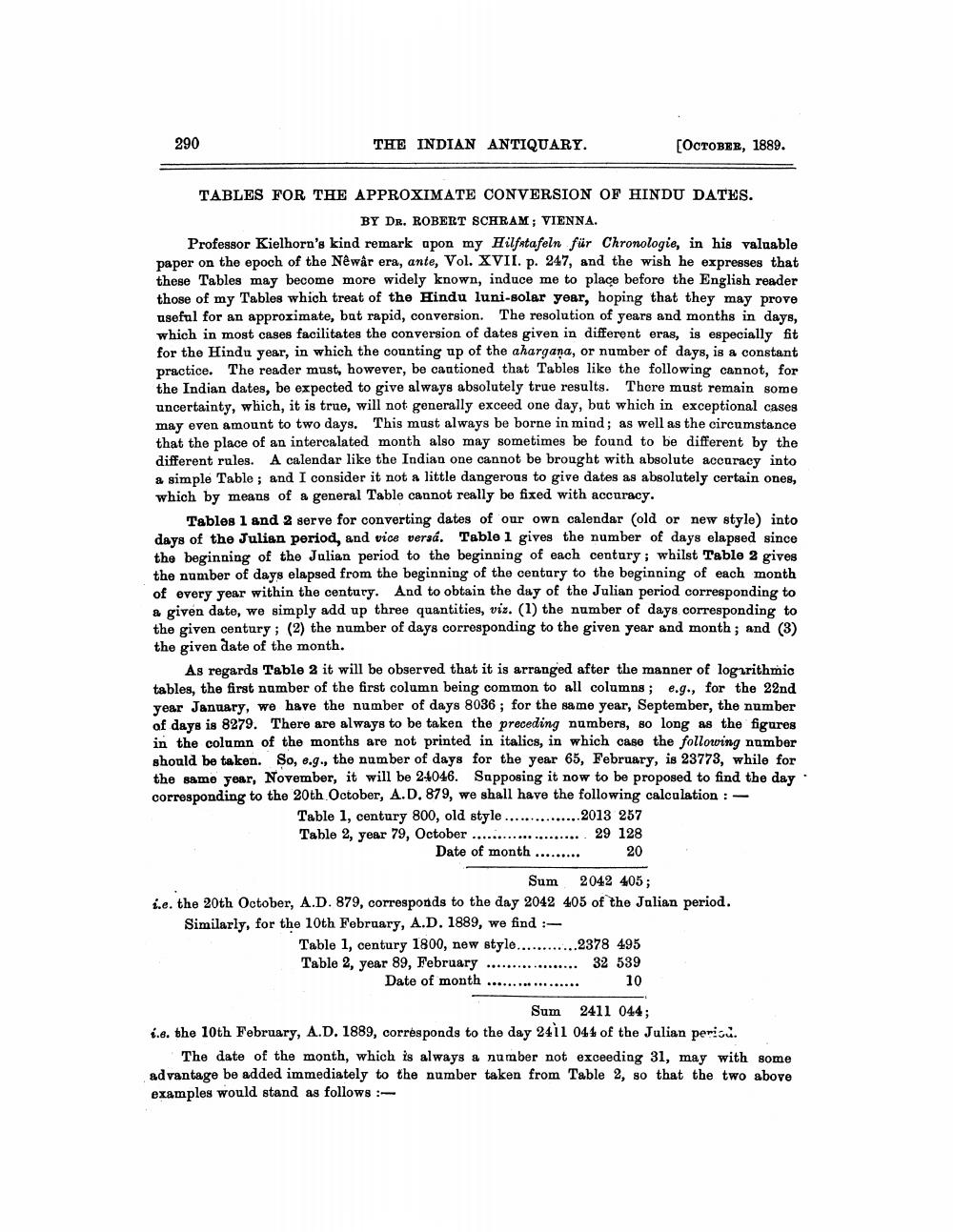________________
290
THE INDIAN ANTIQUARY.
TABLES FOR THE APPROXIMATE CONVERSION OF HINDU DATES.
BY DR. ROBERT SCHRAM; VIENNA.
Professor Kielhorn's kind remark upon my Hilfstafeln für Chronologie, in his valuable paper on the epoch of the Nêwâr era, ante, Vol. XVII. p. 247, and the wish he expresses that these Tables may become more widely known, induce me to place before the English reader those of my Tables which treat of the Hindu luni-solar year, hoping that they may prove useful for an approximate, but rapid, conversion. The resolution of years and months in days, which in most cases facilitates the conversion of dates given in different eras, is especially fit for the Hindu year, in which the counting up of the ahargana, or number of days, is a constant practice. The reader must, however, be cautioned that Tables like the following cannot, for the Indian dates, be expected to give always absolutely true results. There must remain some uncertainty, which, it is true, will not generally exceed one day, but which in exceptional cases may even amount to two days. This must always be borne in mind; as well as the circumstance that the place of an intercalated month also may sometimes be found to be different by the different rules. A calendar like the Indian one cannot be brought with absolute accuracy into a simple Table; and I consider it not a little dangerous to give dates as absolutely certain ones, which by means of a general Table cannot really be fixed with accuracy.
Tables 1 and 2 serve for converting dates of our own calendar (old or new style) into days of the Julian period, and vice versa. Table 1 gives the number of days elapsed since the beginning of the Julian period to the beginning of each century; whilst Table 2 gives the number of days elapsed from the beginning of the century to the beginning of each month of every year within the century. And to obtain the day of the Julian period corresponding to a given date, we simply add up three quantities, viz. (1) the number of days corresponding to the given century; (2) the number of days corresponding to the given year and month; and (3) the given date of the month.
[Остовив, 1889.
As regards Table 2 it will be observed that it is arranged after the manner of logarithmic tables, the first number of the first column being common to all columns; e.g., for the 22nd year January, we have the number of days 8036; for the same year, September, the number of days is 8279. There are always to be taken the preceding numbers, so long as the figures in the column of the months are not printed in italics, in which case the following number should be taken. So, e.g., the number of days for the year 65, February, is 23773, while for the same year, November, it will be 24046. Supposing it now to be proposed to find the day. corresponding to the 20th October, A.D. 879, we shall have the following calculation: -
********..
Table 1, century 800, old style... 2013 257 Table 2, year 79, October....... Date of month.........
.............................
29 128 20 Sum 2042 405;
i.e. the 20th October, A.D. 879, corresponds to the day 2042 405 of the Julian period. Similarly, for the 10th February, A.D. 1889, we find :
Table 1, century 1800, new style...2378 495 Table 2, year 89, February 32 539 10 Sum 2411 044;
Date of month
i.e. the 10th February, A.D. 1889, corresponds to the day 2411 044 of the Julian period.
The date of the month, which is always a number not exceeding 31, may with some advantage be added immediately to the number taken from Table 2, so that the two above examples would stand as follows:
********..
********




